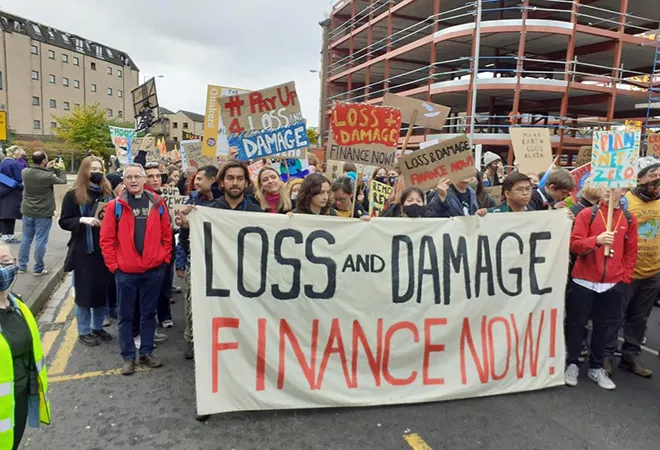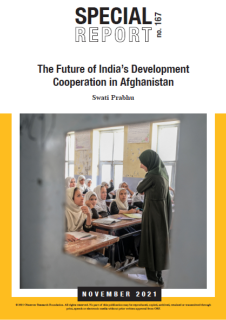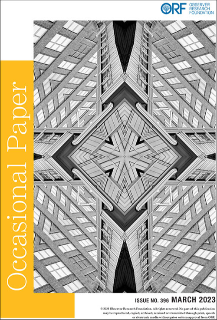
This piece is part of the series, Common But Differentiated Responsibility: Finding Direction In COP27
Lofty hopes are pinned on the 27th Conference of Parties (COP27) this year in Sharm el-Sheikh, Egypt, to galvanise climate action and accountability on loss and damage finance (L&D) that goes beyond talk shop. For developing countries, including India, L&D finance will be a key negotiation point. Economic L&D from climate change is expected to be around 1.8 percent of India’s GDP annually by 2050. It is, therefore, unsurprising that Bhupendra Yadav, Union Minister of Environment, Forest and Climate Change, committed to “constructively and actively” engage on the subject of L&D finance at the climate conference. He emphasised the criticality of ensuring alternative funding arrangements for L&D, especially given that the current financial mechanisms under the UNFCCC framework, including the Global Environment Facility, Green Climate Fund, and Adaptation Fund, are extremely under-funded and inadequate in prioritising L&D claims of disaster struck nations.
The the current climate finance architecture fails to acknowledge, let alone address loss and damage within its purview.
The rise of unprecedented and widespread climate disasters globally has caused profound impacts on human sustenance and survival, with disproportionate consequences for low-and middle-income countries. Between 2008 and 2018 alone, the overall economic toll was recorded highest for Asia at US$49 billion, followed by Africa at US$30 billion, and Latin America and the Caribbean at US$29 billion. Notwithstanding the mitigation and adaptation efforts the developing countries will be compelled to undertake, the impact of climate change in annual “residual damages” cannot be prevented, and the region is likely to face loss and damage costs of US$290-580 billion by 2030 and US$1-1.8 trillion by 2050.
The imperative calls for L&D financing to emerge as a crucial third pillar on climate action, besides mitigation and adaptation, to help communities recover in the aftermath of a climate disaster. However, the current climate finance architecture fails to acknowledge, let alone address loss and damage within its purview. The reason perhaps lies in the politics shrouding the debate since its genesis, thus, warranting a closer look.
As sufficiently evidenced, rising sea levels have been posing a veritable existential threat to small island developing states threatening loss of land, livelihoods, and sovereignty. In response to posit collective action, a coalition emerged with the Alliance of Small Island States (AOSIS) and made demands for an independent status for L&D under the UNFCCC framework in 1992. However, it failed to gain sufficient support from member countries. The developed world was apprehensive that acknowledging L&D would legitimise its accountability for historical emissions; the larger developing countries feared diversion of constrained climate finance and technology flows; the Arab nations found it in their interest to steer the discourse as far away from its oil-producing status.
It took almost 15 years since UNFCCC’s inception for L&D to be referenced in a negotiated UN text, under the Bali Action Plan of 2007 which highlighted the significance of disaster risk reduction by means of insurance and loss and damage, however, it continued to be subsumed under the umbrella of the Adaptation Policy. Later in 2012, after much debate and digression on the matter, an international mechanism on loss and damage was agreed upon at the Doha climate talks but it was again instituted under the Adaptation Framework with little clarity on the scope of the mechanism.
It took robust evidential analyses presented by the Intergovernmental Panel on Climate Change (IPCC) for L&D to be recognised institutionally by the UNFCCC at COP19 in 2013, with the setting up of the Warsaw International Mechanism for Loss and Damage (WIM), albeit tangential reference was made to finance or equity considerations. Eventually, at COP21, L&D was enshrined as a distinct Article 8 of the Paris Agreement. It was celebrated as a landmark milestone in climate negotiations despite the caveat on finance to be extended only “on a cooperative and facilitative” basis.
Despite years of lobbying to provide L&D with its much-deserved independent status “beyond adaptation”, the industrialised countries have deployed several stalling tactics, dangling hope but detaining action on the matter.
It is clear that the debate on L&D has suffered a protracted beating. Despite years of lobbying to provide L&D with its much-deserved independent status “beyond adaptation”, the industrialised countries have deployed several stalling tactics, dangling hope but detaining action on the matter. The debate has been mired in constructive ambiguity, deliberately disguising the unwillingness of the developed countries to commit to providing finance with the sophistry of non-transformative solutions. The verbiage in the official texts remains highly speculative, convoluting the landscape of climate diplomacy with adverse implications on the flows of finance and as a result on climate resilience. This unequivocal denial of the Global North to conflate L&D with liability or compensation exposes the hypocrisy of the western world to avoid paying for its carbon decadent growth and transfer the burden on countries least responsible for climate change.
Given escalating climate disasters globally, AOSIS has been joined by the G77, a coalition of 134 developing countries, and China, demanding financial assistance to help revive and resuscitate its economy in the face of a potential climate catastrophe. It becomes critical that climate-vulnerable nations have access to predictable and reliable sources of finance and are not held “hostage to random acts of charity” as in the case of humanitarian aid. Moreover, if developing countries are left to fend for themselves, their constrained fiscal budgets will have to provide precedence to the exigencies of climate disasters, derailing progress on respective NDCs and inevitably the universal climate targets.
At the COP26 in Glasgow last year, a proposal for a Loss and Damage Finance Facility (LDFF) was floored by G77 plus China, to ensure a dedicated stream of L&D finance to vulnerable nations, mobilised on the basis of the “polluter pays” principle. Unsurprisingly, the United States, Australia, and the EU rejected the proposal and instead offered a three-year ‘dialogue’. The climate conference in Egypt will be revisiting this demand from the developing countries, who have arrived determined to build consensus for establishing a finance facility to officially address L&D under the UNFCCC framework.
The Nationally Determined Contributions (NDCs) must begin to include demands for loss and damage and the Santiago Network for L&D, established under the aforementioned Warsaw International Mechanism, should be tasked with the responsibility to provide technical assistance to countries to help quantify the level of finance and support needed to manage climate impacts.
Even though L&D has been officially included in the COP27 agenda for the first time, any climate negotiation on the subject that expunges the element of finance from the discourse will be a travesty to the principles of equity and common but differentiated responsibilities (CBDR), enshrined in the Paris Agreement. Assuaging concerns of the developing world with hollow promises and excursive references will not cut it anymore. The Global North must respond, from detaining to delivering strict action on L&D finance which is new and additional to existing commitments. The COP27 is an opportunity to institutionalise loss and damage finance as a permanent agenda item in COP negotiations, and in doing so, it will both reinstill credibility in multilaterism as well as prove its mettle for being touted as “implementation COP”.
The views expressed above belong to the author(s). ORF research and analyses now available on Telegram! Click here to access our curated content — blogs, longforms and interviews.




 PREV
PREV


